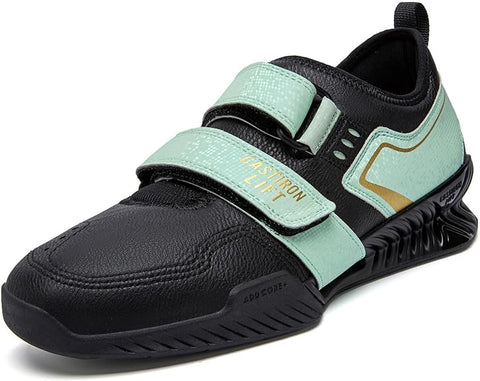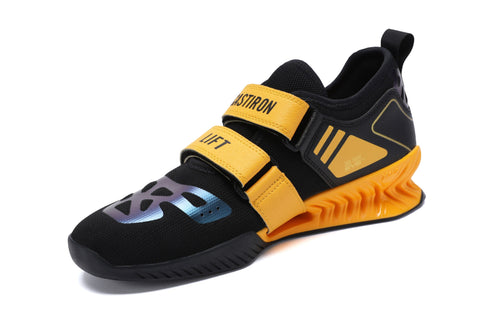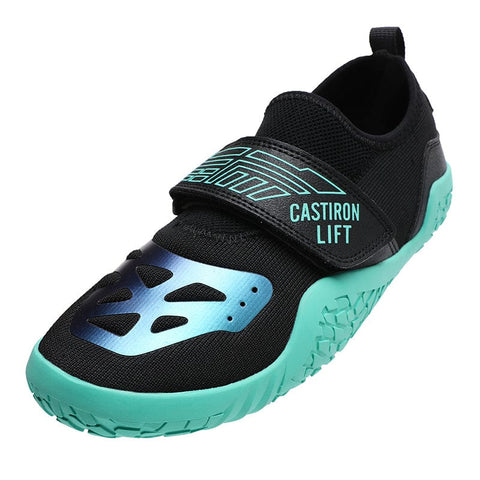4 Reasons to Lift in Weightlifting Shoes!
Weight lifting trainers are an essential piece of equipment for anyone serious about their weight lifting routine. These specially designed shoes provide optimal support and stability, allowing lifters to perform their exercises with proper form and technique. In this article, we will explore the benefits of weight lifting trainers, specifically focusing on weight lifting shoes and squat shoes. Whether you are a seasoned weight lifter or just starting out, understanding the importance of wearing the right footwear can greatly enhance your performance and help prevent injuries.
Weightlifting shoes are helpful in offering a stable base of support for weight lifting of any sort, but they are most useful in offering assistance to athletes when squatting below parallel. In CrossFit, we consider that a full depth squat is when the hip crease goes below the knee. However, as a physical therapist, my objectives for a proper squat are:
-
Heel in contact with the floor
-
No rounding of the lumbar spine
-
Knees tracking over the toes
If you can hit all of these criteria and also get your squat below parallel, you are on track to getting the most out of your squat without increasing your risk for injury. If you could better achieve this position with the use of a weightlifting shoe, I say, go for it! Below is my interpretation of the four reasons you may need weightlifting shoes:
1. ANKLE FLEXIBILITY:
Though not always the case (and often overly labeled as the culprit), there can be a limitation in a person’s ability to fully squat relevant to their ankle mobility. The calf muscles and Achilles tendon can become tight for many reasons: genetics, injury, footwear choices, sports and physical development. Functional tests exist to screen this and can be performed by your physical therapist (consider scheduling a movement screen at Arrow Physical Therapy to learn more about your own ankles). If you have tightness in the ankle or calf, you could be limited in the ability to fully squat or you might find that you feel forward (on your toes even) in a full depth squat. A weightlifting shoe offers a raised heel which accommodates for this limitation by reducing the tension on the Achilles tendon, thus allowing the ankle joint to dorsiflex (bend). The athlete below is unable to keep his heels on the ground.

2. HIP PAIN OR TIGHTNESS:
Hip pain or tightness can limit the ability to squat fully without the back rounding at the bottom of the squat. This is because if the femoral head (top of the thigh bone) cannot glide back into the socket of the pelvis, the pelvis will tuck under in order to get the body to drop the hip crease below the knees. Though this is a “good rep” and full depth, it can be painful and can cause injury to the low back and hips over time.

Because of the change in balance that is offered by the shoe (more on this below), the athlete can hinge at the hip much easier and allow that posterior glide of the femur, allowing for a more correct full depth squat. Of course there are many reasons why an athlete might lose the straight position of the spine and exhibit what we call a “butt wink” at the bottom of a squat. But, if weight lifting shoes can help to minimize this, why not give it a go and try to reach fuller, more correct squat positions so that you can strengthen and improve that position? Please note that if you are having hip pain, consider a full examination by a physical therapist who specializes in Find Relief from Hip Impingement with Expert Advice and Proven Strategies.
3. BALANCE POINT
Many athletes, especially those who are new to the squat, feel very forward in their squat position:
This position often gets worse when the athlete tries to progress to the overhead squat or snatch. And consequently, the victimized structure is, more often than not, the shoulder:
Mobility work with a dowel won’t correct the problem; but, a weightlifting shoe might … A weightlifting shoe positions your weight forward onto the toes. Because of this, when you hinge the hips back and start your descent into the squat, you are able to stay back on the heels (you know, the cue your coach is always screaming at you!). Neurologically, your brain recognizes that this is safe and relaxes the front of the ankle joint and hip flexors (which are often responsible for pulling you forward). Because you can sit your weight back and truly hinge at the hips, you don’t have to fight so hard to keep your trunk upward and (hopefully) the back doesn’t round at the bottom. If you can keep an upright trunk when you have the counterbalanace of a weight in front of you or the use of a doorjam or rig to support you, then this is likely a deficit in motor patterning and just needs practice. Again, the right shoe that can assist the right position, is a wonderful tool to add in so that you can get that proper practice.
In addition to the raised heel, the materials used in a lifting shoe are important. Runners run in running shoes, dancers dance in ballet slippers, character heels, a pointe shoe, or other specific shoes designed for their type of dance. Weightlifting requires a firm, stable platform to push off from and land on. The base of a weightlifting shoe is made of wood or thermoplastic polyurethane. This material and the way the shoe is designed allow the forces to spread evenly through the sole. Notice how unstable you might feel if you are doing jerks overhead in running shoes. Those shoes are made for running and have an inbuilt cushion to absorb impact with each step you take. This is great for running, but not for weightlifting. Rather than absorb force, you need a shoe that will help you use all the force your body produces to help you move weight. The more force you can produce, the more weight you can move. (But, please note I do not recommend wearing weight lifting shoes for running or box jumps due to the inability of the shoe to offer shock absorption during these activities.)

A weight lifting shoe is not a crutch; it is a tool. If used properly, it can help you to achieve the best position for your squat and you will strengthen in this position both muscularly and neurologically. You will become better at squatting. You will get stronger, more mobile, and be able to lift more weight. Your motor patterns will improve and you won’t have to think so much about position as you go into your squat. Over time, this will become more and more natural. And many times, after working in weight lifting shoes for several months or years, you can start to squat without them and achieve a much better position. This ability becomes critical for those WODs such as “Nancy” which involve an overhead squat and running.
So, go get yourself a pair of lifters. They should last you at least 2 years and will be worth the money. Proper form is important to the longevity of your participation in your sport. Remember, a tool, not a crutch! To the CrossFitters out there: keep working hard and reach out to me if you need physical therapy help!
Weight Lifting Shoes
Weight lifting shoes are specifically designed to provide stability and support during weight lifting exercises. These shoes typically have a raised heel, which helps to improve ankle mobility, allowing lifters to achieve a deeper squat position. Additionally, weight lifting shoes have a firm, non-compressible sole that provides a solid base of support, enabling lifters to generate maximum force and power through their lifts.
One of the key features of weight lifting shoes is their elevated heel. This heel height helps to improve ankle mobility, particularly in exercises that require a deep squat position, such as back squats and front squats. By allowing the lifter to achieve a greater range of motion in the ankle joint, weight lifting shoes enable lifters to maintain proper form and technique throughout the entire squat movement. This not only reduces the risk of injury but also allows lifters to lift heavier weights and maximize their performance.
In addition to the elevated heel, weight lifting shoes also have a firm and non-compressible sole. This firmness provides a stable base of support, allowing lifters to transfer maximum force to the ground. Unlike regular athletic shoes, which often have softer soles that can compress under heavy loads, weight lifting shoes ensure that the lifter's power is not wasted by being absorbed by the shoe. The solid base of support provided by weight lifting shoes allows lifters to generate more force from the ground up, resulting in more efficient and effective lifts.
Weight lifting shoes also typically have a secure and snug fit. This is important for maintaining stability and preventing the foot from moving around inside the shoe during lifts. The secure fit of weight lifting shoes helps to prevent slipping and sliding, ensuring that the lifter can maintain proper foot position and stability throughout their lifts. This is particularly important in exercises such as deadlifts, where any movement or instability in the foot can greatly affect the lifter's ability to lift heavy weights safely.
In summary, weight lifting shoes are designed to provide lifters with optimal support and stability during weight lifting exercises. The elevated heel improves ankle mobility, allowing for a deeper squat position, while the firm and non-compressible sole provides a stable base of support for generating maximum force. The secure fit of weight lifting shoes ensures that the foot remains stable and secure throughout lifts, reducing the risk of injury and improving overall performance.
Squat Shoes
Squat shoes, also known as squatting shoes or lifting shoes, are a specific type of weight lifting shoe that are designed specifically for squatting exercises. These shoes provide additional benefits and features that are specifically tailored to the demands of squatting, making them a popular choice among weight lifters and powerlifters.
One of the key features of squat shoes is their elevated heel. Similar to weight lifting shoes, squat shoes typically have a raised heel that helps to improve ankle mobility. This improved ankle mobility allows lifters to achieve a deeper squat position, which in turn helps to engage the muscles of the legs and hips more effectively. By allowing for a greater range of motion in the ankle joint, squat shoes enable lifters to maintain proper form and technique throughout the entire squat movement, reducing the risk of injury and maximizing performance.
In addition to the elevated heel, squat shoes also often have a wider and more stable base compared to regular weight lifting shoes. This wider base provides enhanced stability, allowing lifters to feel more grounded and secure during their squats. The wider base of squat shoes helps to distribute the weight more evenly across the foot, reducing the risk of rolling or tilting to the sides, which can lead to loss of balance or improper form. This stability is particularly important when lifting heavier weights, as any instability in the foot can greatly affect the lifter's ability to perform the movement safely and effectively.
Another key feature of squat shoes is their solid and non-compressible sole. Similar to weight lifting shoes, squat shoes have a firm sole that ensures maximum force transfer from the lifter to the ground. This solid base of support allows lifters to generate more power through their squats, resulting in more efficient and effective lifts. Additionally, the non-compressible sole of squat shoes helps to prevent the lifter's feet from sinking or shifting during the movement, providing a stable foundation for the entire lift.
In summary, squat shoes are a specialized type of weight lifting shoe that are specifically designed for squatting exercises. The elevated heel improves ankle mobility, allowing for a deeper squat position, while the wider and more stable base provides enhanced stability during the lift. The solid and non-compressible sole ensures maximum force transfer and prevents any sinking or shifting of the feet. These features make squat shoes a popular choice among weight lifters and powerlifters looking to optimize their squatting performance and prevent injuries.
Why Wear Weight Lifting Shoes
Now that we have explored the benefits of weight lifting shoes and squat shoes, let's discuss why it is important to wear these specialized footwear during weight lifting exercises. Whether you are a beginner or an experienced lifter, investing in a pair of weight lifting shoes can greatly enhance your performance and help prevent injuries. Here are some reasons why wearing weight lifting shoes is important:
-
Improved Stability and Balance: Weight lifting shoes provide optimal stability and balance during weight lifting exercises. The elevated heel and firm sole of these shoes help to distribute the weight more evenly across the foot, allowing lifters to feel more grounded and secure. This improved stability and balance not only reduces the risk of falling or losing balance but also enables lifters to lift heavier weights with proper form and technique.
-
Enhanced Ankle Mobility: The elevated heel of weight lifting shoes improves ankle mobility, particularly in exercises that require a deep squat position. By allowing for a greater range of motion in the ankle joint, weight lifting shoes enable lifters to maintain proper form and technique throughout the entire squat movement. This improved ankle mobility not only reduces the risk of injury but also allows lifters to perform squats more effectively and efficiently.
-
Increased Power and Force Generation: The firm and non-compressible sole of weight lifting shoes provides a solid base of support, allowing lifters to generate maximum force and power through their lifts. Unlike regular athletic shoes, which often have softer soles that can compress under heavy loads, weight lifting shoes ensure that the lifter's power is not wasted by being absorbed by the shoe. The solid base of support provided by weight lifting shoes allows lifters to transfer more force from the ground up, resulting in more efficient and effective lifts.
-
Prevention of Injuries: Wearing weight lifting shoes can help prevent injuries during weight lifting exercises. The stability and support provided by these shoes reduce the risk of slipping, sliding, or rolling of the foot, preventing any sudden movements or loss of balance that can lead to injuries. Additionally, the improved ankle mobility and proper form facilitated by weight lifting shoes help to alleviate stress on the joints and muscles, reducing the risk of strains, sprains, and other common weight lifting injuries.
In conclusion, weight lifting shoes are a valuable tool for any weight lifter, whether you are a beginner or an experienced lifter. These shoes provide optimal support and stability, allowing lifters to perform their exercises with proper form and technique. The elevated heel, firm sole, and secure fit of weight lifting shoes improve ankle mobility, enhance stability, increase power and force generation, and help prevent injuries. Investing in a pair of weight lifting shoes can greatly enhance your weight lifting routine and take your performance to the next level.



























